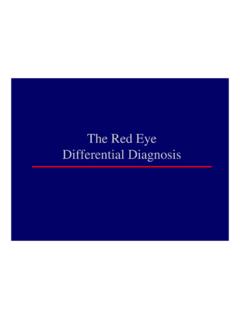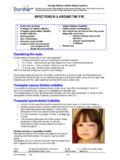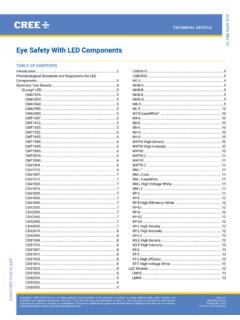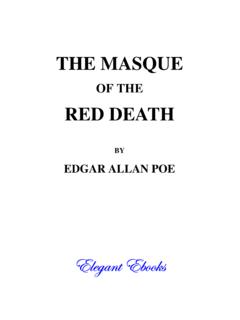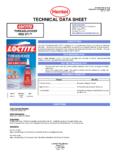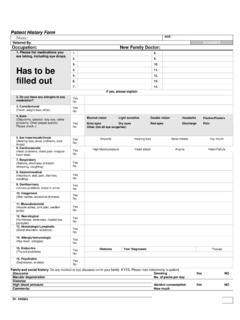Transcription of Rabbit and rodent ophthalmology
1 242 The fascination of comparative ophthalmology lies in the amazing similarity between the eyes of very divergent species. Yet there are small but significant anatomical, physiological and pathobiological differences between the familiar eyes of the dog and cat and those of the Rabbit , guinea pig, mouse and rat which have substantial implications for the treatment of ophthalmic conditions in these animals. Here we seek to outline the differences between rodents and lagomorphs and the more commonly seen dog and cat and discuss the effects these differences have on diagnosis and treatment of ocular disease in these small mammal paper was commissioned by FECAVA for publication in IntroductionRodents and lagomorphs are kept more and more as pet species and thus eye disease may be presented to veterinarians in general practice. They are also seen in research environments and here three key issues necessitate a full understanding of ocular disease.
2 First, wherever they occur, ocular pain and blindness may compromise animal welfare. Second, several eye diseases are important signs of systemic disease with important implications both for pets as well as for laboratory animal colonies. Third, ocular disease may complicate and compromise research efforts. Understanding the similarities and differences between these small mammal eyes and those of the dog and cat is therefore important for veterinarians wherever they may see these clinical techniquesThe small size of rodent eyes makes ophthalmoscopic examination more diffi cult than in dogs or cats. For magnifi cation of the external eye and anterior segment, slit-lamp biomicroscopy is ideal. However fundoscopy can be diffi cult, especially in pigmented strains in which mydriasis is diffi cult. Tropicamide is still worth using but in the same way as occurs with atropine, it is bound to melanin in pigmented irises and thus is less effective than in albino eyes.
3 Many rodent and Rabbit irises also contain atropinase which will degrade the mydriatic rendering it ineffective. Indirect ophthalmoscopy is readily performed in larger species and can, with practice, be mastered in rodents. A 90 dioptre lens can be used with a slit lamp but many prefer a 28-D lens or panretinal lens and an indirect important feature of the rodent eye is the small volume of tear fi lm on the ocular surface. Application of even one standard-size drop will fl ood the ocular surface, thereby leading to nasolacrimal overfl ow. Drugs delivered topically may also be absorbed systemically in signifi cant amounts relative to the (1) David Williams MA VetMB PhD CertVOphthal FRCVS. Department of Veterinary Medicine, University of Cambridge, Cambridge CB3 0ES Rabbit and rodent ophthalmology D. Williams(1)Fig. 1 Shirmer tear test in a guinea pig with unilateral keratoconjunctivitis - Vol.
4 17 - Issue 3 December 2007size of the animal. This has important implications in both the treatment of ocular disease and potential side effects, as the drug may be acting through circulating blood levels as well as by direct ocular ophthalmic tests include determination of tear production and measurement of intraocular pressure. The Schirmer tear test is applicable to rabbits and guinea pigs ( Fig. 1) but the test strip is too large for rats and mice. Breed differences are signifi cant, with Netherland dwarf rabbits having an unusually high Schirmer tear test reading of mm/min compared with an average of mm/min in other breeds, and a range from 0 to 15 mm/min in 142 normal eyes [1]. Evaluation of the tear fi lm in smaller rodents is diffi cult, if not impossible, with the Schirmer tear test strip. Here the Phenol Red Thread Test may be useful (Fig.)
5 2). This test has been used to measure tear volume rather than production in the mouse [2] while another study [3] compared the PRTT with the Schirmer tear test in rabbits fi nding mean wetting of the Schirmer test strip of and mean PRTT wetting of s. A recent paper on tear evaluation in the guinea pig gave a mean STT of mm wetting/min and a mean PRTT-value of 16 mm wetting/15 s) [4]. The glands contributing to the precorneal tear fi lm differ signifi cantly among rodent and lagomorph species [5]. We do not know what contribution to the tear fi lm they make and why they differ so markedly between species. Yet from a pathological perspective these glands may prolapse, in the same way that the nictitans gland does in the dog. Similarly the orbital vascular plexus, present in rodents and lagomorphs, differs substantially between species and understanding its anatomy is important in orbital surgery and enucleation [6].
6 The small size of the globe in many species also complicates methods for measuring intraocular pressure. The Tonopen has been favorably evaluated in rabbits [7] and the small eyes of rats [8] but the footplate is too small for mice. The new rebound tonometer (TonoVet) (Fig. 3) is small enough to provide accurate measurements of intraocular pressure in even the smallest rat and mouse eyes as shown experimentally [9-10] yet its accuracy and repeatability have yet to be reported in the clinical setting for any rodent species. The paucity of reliable evidence in the two basic measures of tear production and intraocular pressure in small mammals just goes to show how much basic work there still is to undertake in this whole interpreting ocular fi ndings in experimental species or pet animals derived from laboratory strains the prevalence of inherited disease must be seen as a background against which other ocular disease is noted.
7 This is particularly important among inbred strains, in which recessive genes may occur in a given strain not being used to study that specifi c trait. The rat and mouseMuch has been written on the ocular diseases of rats, summarized in a recent review paper [11]. A superb overview of the mouse eye has been provided by Smith et al [12]. Further information is available through those is common in rodents and may often relate to mycoplasmal respiratory disease, though other agents can also be involved [13-15]. Young animals are often more severely affected [16]. Environmental changes rather than Fig. 2 The phenol red thread test used in a 4 Chromodacryorhoea in a 3 The Rebound Tonometer is invaluable for measuring intraocular pressure in the small eyes of and rodent ophthalmology - D. Williamsprimary infectious agents may be the most important factors in conjunctival infl ammatory disease: ventilation currents in rodent cages may produce airborne suspensions of fi ne bedding matter giving rise to a severe keratoconjunctivitis [17].
8 Investigating a problem such as conjunctivitis in such a group of rodents thus requires a full and thorough history and clinical examination of individual animals as well as of the group as a the most severe adnexal disease in laboratory rats is sialodacryoadenitis (SDA) virus infection [18]. This coronavirus infection causes ocular irritation with conjunctivitis and periorbital swelling, followed by sneezing and cervical swelling [19]. The condition is usually self-limiting within one to two weeks, whereas resolution of secondary signs may take longer. The immune status of the animals is a critical factor in disease severity [20]; introduction of a naive group of rats into a subclinically affected animal house may provoke clinical onset of severe disease in these animals. Serologic testing has shown the agent to be present in 45% of rat colonies within the United Kingdom, though the incidence of overt disease is signifi cantly lower [21].
9 Many laboratory rodents exhibit red crusting around their eyes in cases of ocular irritation, upper respiratory tract infection, and stress (Fig. 4). Porphyrin pigmented tears are produced in normal amounts by the Harderian glands in several rodent species [22] but particularly in the rat but also some other rodent species, excess tear production with characteristic red deposits on the periorbital fur, nose, and paws after wiping the eyes, so-called chromodacryorhhoea, is seen [23]. Diseases such as mycoplasmosis and sialodacryoadentitis (SDA), nutritional defi ciencies, and other physiologic stresses are factors that may cause chromodacryorrhea. Appropriate remedial action should be taken to remove the stressors involved be they infectious, environmental or managemental [24]. A common problem in laboratory rodents is microphthalmos with a valuable overview provided by Smith et al [25].
10 A number of transgenic rodents are inadvertently affected by this condition with clinical features [26] including microcornea, engorged episcleral vessels, and abnormal ocular vasculature (Fig. 5) and welfare implications given visual dysfunction and the propensity to develop defective tear drainage together with microbial contamination of the deep conjunctival sac [27]. Corneal opacifi cation is relatively common in rodents. Spontaneously occurring dystrophic lesions manifest as elliptical paracentral corneal opacities, characterized by a deposition of basophilic material in the subepithelial stroma (Fig. 6). Some workers consider them heritable [29] while others suggest the Fig. 5 Murine microphthalmos with engorged episcleral and iridal vessels. Courtesy Dr. Peter 6 Corneal dystrophy in a CD1 mouse. Courtesy Dr. Peter 7 Post-anaesthetic exposure keratopathy in a - Vol.
